Square Root in Excel is a fundamental mathematical operation, and mastering the SQRT function is essential for anyone looking to perform complex calculations or analyze data sets accurately. Whether you’re a student dealing with mathematical problems, an engineer calculating root mean square values, or an analyst determining standard deviations, ability to calculate the square roots directly in Excel is incredibly valuable. This guide will lead you through the nuances of the SQRT function in Excel, providing you with the knowledge to efficiently compute square roots and thereby enhance the depth and precision of your data analysis. By integrating this function into your Excel toolkit, you’ll unlock new potentials in your data calculations and presentations.
This tutorial demonstrates how to compute the Nth root of any variable as well as how to square a root in Excel.
This Tutorial Covers:
- What is the SQRT Function?
- How to square root in Excel using SQRT function?
- How to do square root in Excel using a calculation?
- Why is an exponent of 1/2 the same as square root?
- How to find square root with POWER function?
- How to calculate Nth root in Excel?
- Things to remember about the SQRT Function
1. What is the SQRT Function?
A trigonometry and math function in Excel is called the SQRT Function[1]. It will give the positive number’s square root. MS Excel 2010 introduced the function.
Syntax:
=SQRT(number)
The SQRT function uses the following argument:
number (mandatory argument) – This is the number whose square root we’re interested in finding. A function that yields a positive number, an Excel formula, or a positive number must be used.
2. How to square root in Excel using SQRT function?
Using the function created specifically for this in Excel is the simplest approach to perform square roots:
=SQRT(number)
where number is the number or a citation to the cell where the number you wish to compute the square root of is located.
How to use the SQRT function:
Step 1: Use this formula to find the square root of an integer in A2:
=SQRT(A2)
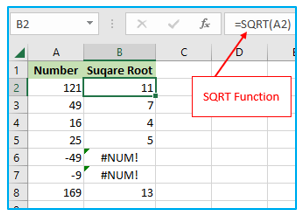
The #NUM! error is returned by the Excel SQRT function when a number is negative, like in rows 6 and 7 in the screenshot above. This occurs because there is no negative square root among the set of real numbers. How come that? Since squaring an integer cannot produce a negative outcome,
Wrap the source number in the ABS function, which returns the absolute value of a number regardless of its sign, if you want to take the square root of a negative number as if it were a positive number:
=SQRT(ABS(A2))
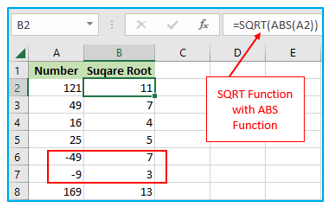
3. How to do square root in Excel using a calculation?
When performing a calculation by hand, the radical symbol (√) is used to represent the square root. Even though Excel does not support the classic square root symbol, there is a technique to find the square root directly. On most keyboards, the caret character (^), which is found above the number 6, is used for this.
In Microsoft Excel, the exponent, or power, operator is represented by the caret symbol (^). For example, to square, the number 3, i.e., raise 3 to the power of 2, you type =3^2 in a cell, which is equivalent to “32”.
Use the caret with (1/2) or 0.5 as the exponent to obtain the square root:
number^(1/2) or number^0.5
For example, to get the square root of 121, you type =121^(1/2) or =121^0.5 in a cell.
To find square root of a number in A2, you type:
=A2^(1/2) or =A2^0.5
The results of the exponent formula and the excel square root function are the same, as can be seen in the screenshot below:
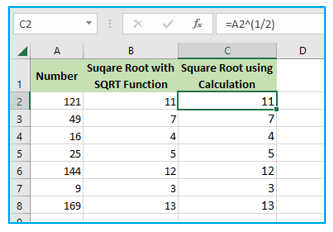
This expression for the root square in excel can also be used into larger calculations. For instance, the IF statement below instructs Excel to compute a square root based on the circumstance: if A2 has a number, return the square root; otherwise, return an empty string (blank cell):
=IF(ISNUMBER(A2), A2^(1/2), ” “)
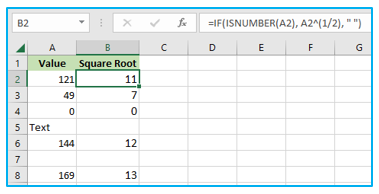
4. Why is an exponent of 1/2 the same as square root?
What is a square root, to begin with? Nothing more than a number that provides the original number whenever multiplied by itself can be said regarding it.
Well, multiplying 491/2 by itself also gives 49:
491/2 x 491/2 = 49(1/2+1/2)= 49(1) = 49
Said another way:
√49x √49= 49
And:
491/2 x 491/2 = 49
So, 491/2 is equivalent to √49.
5. How to calculate square root with POWER function?
The above calculation, or raising an integer to the power of 1/2, can also be done using the POWER function.
The Excel POWER function’s syntax is as follows:
POWER(number, power)
As is obvious, you need to supply 1/2 to the power of the argument to obtain the square root. For instance:
=POWER(A2, 1/2)
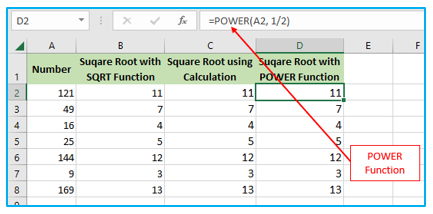
Which of the 3 square root formulas you choose to utilize depends on your personal preference, as seen in the screenshot above.
6. How to calculate Nth root through formula in Excel?
Finding merely a square root excel is not the only application of the exponent formula explained a few lines ago. You may obtain any nth root using the same methods; simply write the root you want in the denominator of a fraction after the caret character:
number^(1/n)
Where n is the root and number is the number whose root you’re trying to find.
For instance:
- The cube root of 49 would be written as: =49^(1/3)
- To get the 4th root of 49, you type: =49^(1/4)
- To find the 5th root of a number in cell A2, you type: =A2^(1/5)
If the fraction’s decimal version contains a sufficient number of decimal places, you can substitute decimal integers for fractions in exponents. For instance, to calculate the 4th root of 81, you can go with either =81^(1/4) or =81^0.25.
To ensure the correct order of operations in your square root formula—first division (the forward-slash (/) is the division operator in Excel—and then raising to the power—please note that fractional exponents should always be placed in parenthesis.
The POWER function can produce the same outcomes:
- The cube root of 49: =POWER(49, 1/3)
- The 4th root of 49: =POWER(49, 1/4)
- The 5th root of a number in cell A2: =POWER(A2, 1/5)
You can enter the roots in different cells of your worksheets for real-world problems and then make references to those cells in your calculations. Here’s an illustration of how to determine the number in A3’s root input in B2:
=$A3^(1/B$2)
The outcomes are displayed in the screenshot below, rounded to two decimal places:
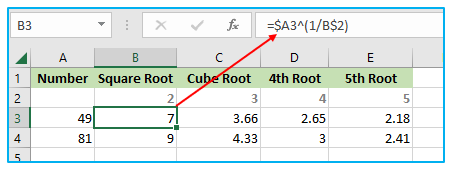
Tip: Use the dollar sign ($) to fix a column and/or row reference when necessary to do many computations with a single formula, like in the example above. Please refer to Why use the dollar symbol in Excel calculations for additional details.
7. Things to remember about the SQRT Function / square root formula in Excel:
- When the given number parameter is negative, the #NUM! error appears. To avoid this error, you must use SQRT Function with the ABS Function.
- Depending on the user’s needs, the SQRT function can be combined with the ABS, ROUND, ROUNDUP, and ROUNDDOWN functions.
The SQRT function resembles the POWER function. The POWER function, however, behaves like an exponent in a regular math equation. For instance, we shall give the formulas =SQRT(49) and =POWER(49, 1/2) for the integer 49.
For ready-to-use Dashboard Templates:
